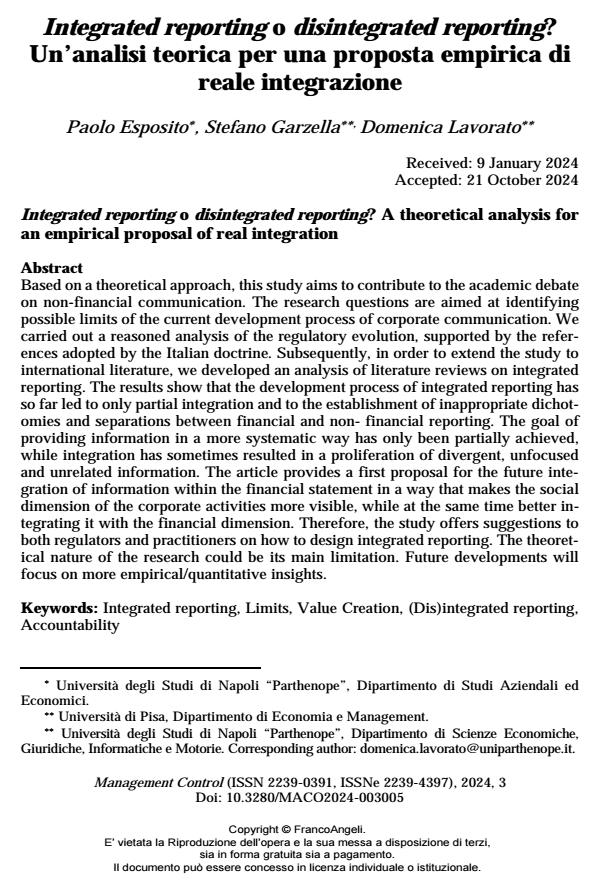Integrated reporting o disintegrated reporting? A theoretical analysis for an empirical proposal of real integration
Journal title MANAGEMENT CONTROL
Author/s Paolo Esposito, Stefano Garzella, Domenica Lavorato
Publishing Year 2024 Issue 2024/3
Language Italian Pages 24 P. 87-110 File size 140 KB
DOI 10.3280/MACO2024-003005
DOI is like a bar code for intellectual property: to have more infomation
click here
Below, you can see the article first page
If you want to buy this article in PDF format, you can do it, following the instructions to buy download credits

FrancoAngeli is member of Publishers International Linking Association, Inc (PILA), a not-for-profit association which run the CrossRef service enabling links to and from online scholarly content.
Based on a theoretical approach, this study aims to contribute to the academic debate on non-financial communication. The research questions are aimed at identifying possible limits of the current development process of corporate com-munication. We carried out a reasoned analysis of the regulatory evolution, sup-ported by the references adopted by the Italian doctrine. Subsequently, in order to extend the study to international literature, we developed an analysis of literature reviews on integrated reporting. The results show that the development process of integrated reporting has so far led to only partial integration and to the establish-ment of inappropriate dichotomies and separations between financial and non- financial reporting. The goal of providing information in a more systematic way has only been partially achieved, while integration has sometimes resulted in a pro-liferation of divergent, unfocused and unrelated information. The article provides a first proposal for the future integration of information within the financial statement in a way that makes the social dimension of the corporate activities more visible, while at the same time better integrating it with the financial dimen-sion. Therefore, the study offers suggestions to both regulators and practitioners on how to design integrated reporting. The theoretical nature of the research could be its main limitation. Future developments will focus on more empirical/quantitative insights.
Keywords: Integrated reporting, Limits, Value Creation, (Dis)integrated reporting, Accountability
- Integrated Reporting as a managerial tool: The role of Integrated Thinking Anna Pistoni, Lucrezia Songini, in MANAGEMENT CONTROL 2/2025 pp.85
DOI: 10.3280/MACO2025-002005
Paolo Esposito, Stefano Garzella, Domenica Lavorato, Integrated reporting o disintegrated reporting? Un’analisi teorica per una proposta empirica di reale integrazione in "MANAGEMENT CONTROL" 3/2024, pp 87-110, DOI: 10.3280/MACO2024-003005